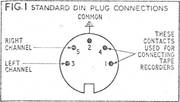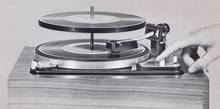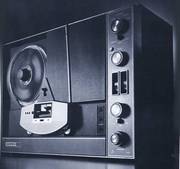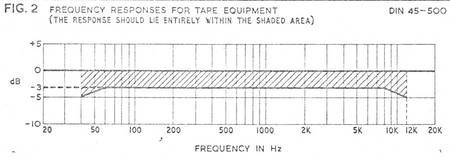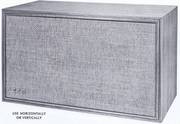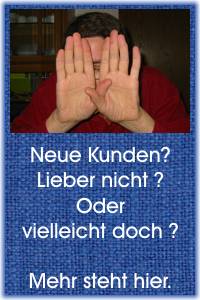In den englischen Hifi-News 7/1968 erschien dieser Artikel :
BY GORDON J. KING - schreibt er auf 2 Seiten :
Das ist natürlich nur eine englische Kurzfassung in einem Magazin mit Hinweisen auf die wichtigsten Daten und Werte - vor allem aber auf die Regelungswut der Deutschen - diesmal aber auf niedrigem technisch Niveau zum Verstehen für Engländer, die solch ein Gerät mit DIN-Buchsen benutzen wollen oder müssen.
.
DIN 45-500 - details of a German standard for hi-fi equipment
Just what standards should a piece of equipment attain before it can justly be called hi-fi ? This is a matter for some debate, but in 1966 the German standards body (Deutscher Industrie Normenausschuss) published din 45-500 which specifies minimum requirements for nonprofessional equipment.
.
It also includes a standard DIN plug (fig. 1) which manufacturers of all types of equipment should adhere to - even if the performance of their products deviates from the standard; there are other DIN plugs and standards exist for these too. The standard has already been subject to some criticism, but rather than comment for the moment I will briefly present the DIN proposals for readers to consider.
At the outset it must be understood that the standard is based on what DIN considers to be minimum requirements for hi-fi. Probably the nearest British document to the DIN is that evolved in 1960 by the Audio Group of BREMA {British Radio Equipment Manufacturers' Association) and finally published as British Standard 3860 in 1965, but this is concerned essentially with measuring and expressing performance of amplifiers.
Since climatic conditions can affect the nature of sound and the means of amplification and reproduction, the DIN assumes ambient temperatures of 15° - 35°C, relative humidity between 45 - 75% and atmospheric pressures between 860-1060 milli-Bar.
The Standard highlights the importance of taking into account possible differences in tolerance, rating, electrical and mechanical connections and so forth when assembling or enlarging a domestic hi-fi system with units from different sources, and the need for clear labelling of control functions is stressed.
FM TUNERS
This section applies to mono and stereo tuners but not to receivers as such (a standard for these is in preparation).
The overall frequency response requirement is 40Hz to 12,5kHz with permissible deviations relative to 1 kHz of ±3dB from 40-50 Hz, ± 1,5dB from 50Hz to 6,3kHz and ±3dB from 6,3 to 12,5kHz.
Maximum permitted disparity between stereo channels is 3dB from 250Hz to 6,3kHz. Distortion is measured with a deviation of 40kHz at 1kHz and should not exceed 2% (harmonic). (Anmerkung: was immer das bedeuten soll.)
Stereo tuners should have a separation of 26dB or better from 250Hz to 6,3kHz and 15dB or better from 6.3 to 12,5kHz.
Signal-to-noise ratios are referred to 1kHz modulation at 40kHz deviation. Overall unweighted value should be 46dB or better from 40Hz to 15kHz mono and stereo. Unweighted pilot tone ratios should be 20dB when selectively measured at 19kHz, and 30dB similarly measured at 38kHz.
Many European tuners feature high aerial impedance values (as distinct from the nominal 75 Ohm British standard), and in the DIN standard the performance specification refers to 240 ohms and a signal level of 1mV.
An appendix gives DIN recommendations for the various RF and AF connections, including the DIN socket connections (fig. 1). Tuner AF output should range from 0,5 to 2V across 470K in parallel with 100pF when the RF signal is deviated 40kHz.
RECORD PLAYERS
Both mechanical and electrical aspects are considered in this section, starting with turntable speed tolerances of +1,5 and -1% and variation of ±2%. This is established using the DIN record 45-545 for testing.
Signal-to-rumble ratio is established by DIN record 45-544 and given as 55dB or better when the recorded velocity is 10cm/sec and the frequency 1kHz.
Overall frequency response should be from 40Hz to 12,5kHz with permissible deviations of ±2dB from 63,5Hz to 8kHz and ±5dB from 8 to l2,5kHz. This is established by the DIN test disc 45-541.
Using the same disc, the difference between stereo channels should not exceed 2dB. A test disc for measuring intermodulation distortion was in preparation at the time of publication DIN 45-542 - and the method of measurement is described in DIN 45-507.
System channel separation at1 kHz is 20dB and between 500Hz and 6,3kHz it is 15dB. Disc 45-543 is designed for this test.
Compliance of the cartridge should be at least 4 c.u. vertically and greater than this value laterally. (Anmerkung: was sind c.u.??)
Stylus tip dimensions are spherical 15u ±3u (0,6 mil) and biradial 6u x 20u, with the effective mass at the tip being approximately 2mg.
Vertical tracking angle is given as 15° ±5° and a distortion test disc (DIN 45-542) is being prepared to establish this parameter. Tracking weight as a static measurement is given as not greater than 5 grams.
TAPE EQUIPMENT
General characteristics for tape equipment are given in DIN 45-511. In addition, speed variations are to be held within ±1% over 30 second intervals, wow and flutter should be less than ±0,2% (peak-to-peak!), distortion at 333 Hz should be 5% or less at peak recording level, and the signal-to-noise ratio better than 45dB referred to peak recording level.
Track separation should be 60dB, and stereo separation 25dB - erasure should be 60dB below peak recording level. Fig. 2 shows the permitted response tolerances.
.
MICROPHONES
Minimum frequency range required is 50Hz to 12,5kHz with the optimum curve lying within the limits shown in fig. 3. The dotted line refers to non-directional microphones and the continuous lines to directional ones. The variation should not exceed 3dB in any octave.
A practical curve should follow closely the nature of the optimum curve, but the following tolerances are permissible: ±4dB from 50 to 250Hz, ±3 dB and from 250Hz t 8kHz and ±4dB from 8 to 12,5kHz.
Directional characteristics should not be unduly affected by frequency and non-directional microphones should not deviate in output by more than 12dB over the range 6,9kHz in non-reflective conditions and up to 90° off axis.
Directional microphones should not 'focus' by more than 6dB at any frequency between 250Hz and 8kHz. Within this same range the amplitude of the frequency curve for any angle (other than 0°) should not differ by more than ±4dB from the zero curve.
However, this requirement need not be rigidly followed at parts of the frequency curve that drop below -12dB (ref. 1 kHz) as the total effect is then assumed to be negligible.
The distortion factor is given as less than 1% within the range 250Hz to 8kHz at sound pressures of 100uBar (equivalent to 114dB). Differences between stereo channels between 250 and 8000 Hz should not exceed 3dB. Requirements for plugs are contained in DIN 45-594.
AMPLIFIERS
Frequency response is specified as 40Hz to 16kHz with permissible deviations (at 6dB below full power output) of ±1,5dB for non-equalised inputs and ±2dB for equalised inputs. Tone controls may be adjusted to secure the best response characteristics and volume controls can be fully advanced.
Channel balance on stereo should be better than 3dB in the absence of a balancing control or better than 6dB with a control, provided this provides better than 8dB total variation between 250Hz and 6,3 kHz.
Distortion factor (measured according to DIN 45-403) is not to exceed 1% from preamplifiers at full output from 40Hz to 4kHz, and not to exceed 1% from power amplifiers and integrated amplifiers from full power down to -20dB over a power bandwidth of 40Hz to 12,5kHz (see also 'Power Output' later).
The check down to -20dB is intended to reveal the distortion at low levels where some transistorised amplifiers give increased distortion owing to changes in the output stage biasing with signal power changes and crossover.
Intermodulation distortion is considered separately and should be less than 3% maximum arising from two test signals of 250Hz and 8kHz at an amplitude ratio 4 to l.
Crosstalk between stereo channels is given as -dB or better at 1kHz and 30dB or better between 250Hz and 10kHz. Breakthrough between inputs should be -50dB or better at 1kHz and -40dB or better between 250Hz and 10kHz.
Signal-to-noise ratios on preamplifiers should be better 50dB at the nominal input signal amplitude, and on power amplifiers and integrated amplifiers up to 20W rating the figure is 50dB for 100mW output.
Power output specified is at least 10W mono and at least 2 x 6W stereo, and the amplifier must be capable of producing sine-wave signals at 1kHz for a period of 10 minutes.
The following factors must be clearly stated on equipment: (i) signal inputs (voltages); (ii) input impedances (resistances at 1kHz); (iii) sine-wave output rating; (iv) optimum load resistance.
.
There is a series of supplementary amplifier recommendations, including the following:
Unequalised inputs should have a resistance of 470K loading at 0,5V, and connections should correspond to the DIN plug system (fig. 1).
The nominal sensitivity should relate to the specified output, and when an input goes through a volume control non-linear distortion should be less than 1dB when the inputs are 12dB above nominal levels. Inputs for magnetic pickups (equalised according to DIN 45-536) should load at 47K and possess an input sensitivity of 5mV at 1kHz. Lower input impedances (resistances) are permissible provided the effect on equalisation is taken into account.
Outputs from preamplifiers should be 1V across 47K (it would appear that this is for connection to a partnering power amplifier). Outputs for connection to a tape recorder should be from 0,1mV to 2mV for every 1K of resistance from 1K to 50K - the output matching resistance of power amplifiers and integrated amplifiers should be one of the following: 2, 4, 8, 16, 32, 50, 100, 400 and 800 ohms. The values 4 and 16 ohms are favoured.
SPEAKERS
Fig. 4 shows the tolerances beyond which the measured frequency curve may not deviate. For stereo pairs, the two speakers should not differ from each other by more than 3dB from 250Hz to 8kHz.
The speaker should be capable of developing a sound pressure of 12 uBars (corresponding to 96dB) at a distance of 1 metre or 4 uBars at a distance of 3 metres.
Non-linear distortion at the specified output should be less than 3% from 250Hz to 1kHz and less than 1% at 2kHz and above.
Impedance changes (described in DIN 45-573) are not to exceed ±20% at any frequency within the operating range.
Maximum limits are established for speech and music power handling by feeding in sine-wave signals from 250Hz to the lowest limit of the speaker at short intervals not exceeding two seconds. The 'limits' then represent the loads which the speaker can carry without any audible distortions. Operating impedances are given as 4, 8, and 16 ohms, with the first and last values preferred.
TUNER-AMPLIFIERS (heute sind das Receiver)
This section of the Standard is based on an aerial input of 1mV across 240 ohms and an AF output 6dB below full volume except for distortion factor measurements.
Frequency range at least 40Hz to 12,5kHz with permissible deviations (relative to 1kHz) of ±4,5dB from 40 to 50Hz, ±3dB from 50Hz to 6,3kHz and ±4,5dB from 6,3 to 12,5kHz.
Channel balance, to be not worse than 6dB from 250 to 6,3kHz or not worse than 9dB when balance control is fitted giving an adjustment of at least 8dB.
Distortion should be less than 2,5% at 1kHz with 40kHz deviation (same signal carried by each channel in stereo equipment) with a power bandwidth of 40Hz to 12,5kHz when the output is correctly terminated.
Permissible crosstalk is given as 24dB, 18dB and 14dB respectively at 1kHz, 250 to 6,3kHz and 6,3 - 10kHz.
Unweighted signal-to-noise ratio relative to 100mW (mono) or 2x50mW (stereo) from systems up to 20W output is specified as equal to or better than 41dB over the frequency range 40Hz - 15kHz when the system is initially set for the correct output with an input of 1kHz at 40kHz deviation (FM).
Noise (measured in accordance with DIN 45-405) between 40Hz - 15kHz is given as equal to or better than 50dB for both mono and stereo systems.
Pilot-tone signal-to-noise ratio when measured selectively at 10kHz and 38kHz is equal to or better than 19dB and 29dB respectively. The input signal is a 1kHz tone deviated by 67,5kHz and at a level of 1mV into 240 ohm.
Nachsatz:
Other standards for 'Amplifying Record Players' and 'Amplified Tape Recorders' are also given, but as these items are hardly hi-fi units - and as the relevant parameters have been dealt with more stringently in the relevant sections of the main standard they are not included here.
It is obvious that DIN 45-500 is not a particularly stringent set of requirements - indeed, at least one designer has already spoken sharply of the inadequacies of the specification that is is applied to pickup cartridges - nevertheless it is an attempt to separate 'hi-fi' from 'domestic quality'.
It is not without significance that much of the equipment proudly bearing the hi-fi label available in this country would fail many of the tests suggested by this pretty modest document.

